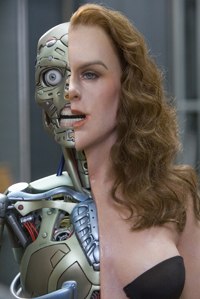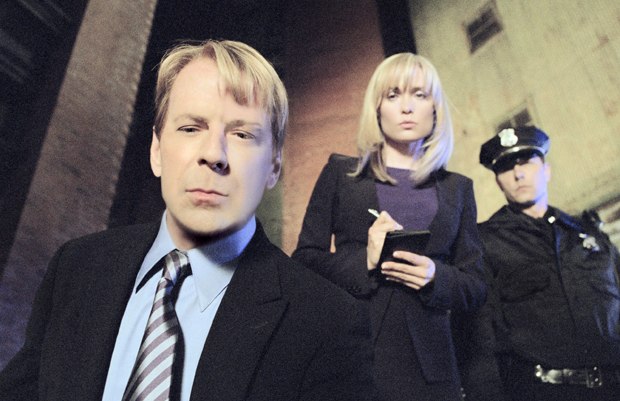Mark Stetson unravels the vfx mysteries of Surrogates.
Check out the Surrogates trailer at AWNtv!
Surrogates, directed by Jonathan Mostow (Terminator 3: Rise of the Machines), offers another dystopian sci-fi thriller, in which the line between human and machine becomes blurred. In this film, people live in isolation and interact through surrogate robots, and Bruce Willis plays a cop forced to leave his home for the first time in years to investigate the murder of surrogates. Mark Stetson, the overall visual effects supervisor, who worked on the landmarkBlade Runner, discusses how they tried to keep it fresh and believable.
"Vfx were really in a supporting role on this and we focused a lot on Bruce Willis' surrogate character and finding his look and making him consistent through the movie, which took a long time," Stetson concedes.

That look was partly driven by the techniques at their disposal. They assigned the work to Synthespian Studios, Jeff Kleiser's company. They scanned a digital double of Willis and Synthespian built a CG model from Eyetronics' scan and original cleanup work. But most of the work was done in 2D in Shake. "There's a lot of matchmoving and roto patching," Stetson continues. "A lot of it was simply to make him look 20 years younger or so. Beyond that, there's a certain level of perfection that we were dancing with. If we had done everything that Jonathan had asked us to do, we would've ended up with something that looks like bad visual effects work. But when you think about it, that look is actually what the movie was asking for. We just couldn't go all the way with it in the visual environment that we're in."
There was some development work during production, according to Stetson, including a challenging shot, but as the movie was cut and seeing it in context, it made them change their minds. There were subtle changes that they were trying to bring to Willis' look.
"We divided his look amongst different portions of the film," Stetson explains. "We dirtied him up a bit for the helicopter crash. It was quite a bit easier to do and so the look evolved through timeline of the film. When he's riding the helicopter, he's a little bit older than after he crashes the helicopter, and then he looks pretty beat up.
"Then the movie became a present-day parallel reality movie, so there are some story points that we really needed to try to make harder with visual effects. One of those is simply [conveying this VSI network], so Jonathan wanted to sprinkle satellite dishes on roofs wherever we could [done by Boston-based Brickyard VFX]. Some of the shots became big deals, but there weren't that many that we could do that in. In that vein, we also had trouble trying to find an establishing shot of the [headquarters], and we had this stock shot that was in the cut forever. But we didn't have any aerials that we could drop a CG headquarters building into. I came up with a couple of potential plates that we had shot for other things, but Jonathan didn't like those. Ultimately, we went with the stock shot we had picked and Brickyard VFX decorated that building nicely with logo signs and a whole nest of satellite dishes. So that helped to convey the telecommunications idea a little bit more.
"Then the biggest shot in that regard is an aerial shot looking down where we see all of the surrogates lying dead in the street and a car crashes and the devastation that follows. Brickyard sprinkled satellite dishes pretty liberally on the rooftops of that shot."
However, the largest share of shots came from Sandbox FX in Massachusetts, owned by John Nugent. They did primarily comp shots but also CG, including all of the driving sequences and the beginning sequence where we first see the OD (Overload) device used in the night club alley, and then the ensuing car crash, as well as the CG factory sequence/assemble in Berkeley.
"Probably the biggest thing is a pivotal death scene using an OD device," Stetson suggests. "It had to match the look of the OD device that MPC Vancouver created for the helicopter crash sequence. But they did that all themselves. There are a couple of components to it: there's the ray blast effect, which is a tussle between trying to find something that looks dramatic and fit in with the rest of the movie, which is pretty normal looking, so it's probably the most science fiction thing we see.

Amid the wreckage Wills tries to solve the mystery: Sandbox FX, MPC Vancouver, Brickyard VFX and ILM provided vfx support.
At one point we thought about doing it with no effect at all, except maybe a muzzle blast from a gun. Ultimately, though, Jonathan decided that it needed the drama of the ray. The second part is the effect on the surrogates themselves, where we see them quiver and they're attacked by this ray and we see the light effects indicating the energy building up inside their heads and eventually their eyes pop and the insides explode through their eyes. It's like one step short of blowing up their heads: a fountain of sparks flying out their eyes."
There were a lot of 2D tools used for this effect along with both CG and photographic spark elements, and they painted some elements to matchmove onto the faces, showing the glow within the skin. The effect of the rays was all in Maya with distortion.
"I had asked them both to develop the [OD effect] and they were both going along and then I asked Sandbox to stop on it for a while, because it seemed for the alley stuff in daylight and in a larger area, MPC had the larger task, so I wanted to make sure they get what they needed first. And then we picked up the Sandbox work later."
ILM also contributed some greenscreen, leaping wire stunts and comp work, too. "There was a car chase sequence shot kind of late around Easter of this year. We shot it at the Paramount backlot in downtown L.A. Maybe a half dozen shots that needed some work."
Bill Desowitz is senior editor of AWN & VFXWorld.








